Razer Blade 14-Inch Gaming Notebook Review
by Dustin Sklavos on July 2, 2013 1:00 PM ESTDisplay Quality
It's unfortunate that one of the hallmarks of Windows notebooks seems to be that the vendor can get almost everything right, and then have one massive, gaping flaw. Unfortunately this remains true of the Razer Blade 14-inch as well. While the Blade has incorporated some of the best elements of Apple notebook design, they neglected to include one of the biggest and most important reasons why people will buy MacBooks: display quality.
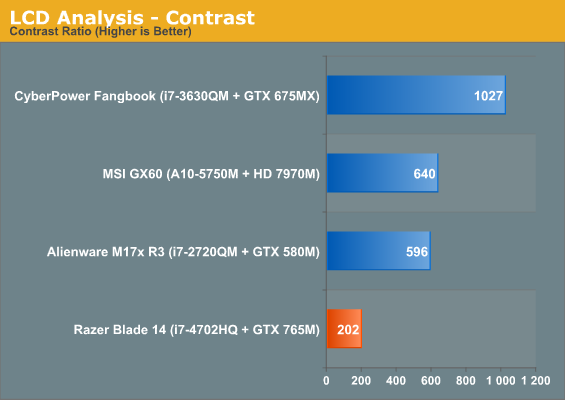
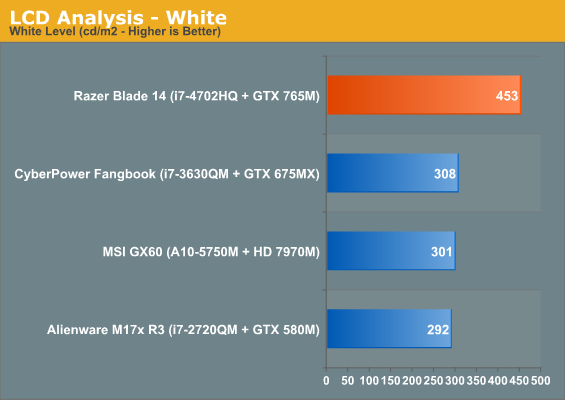
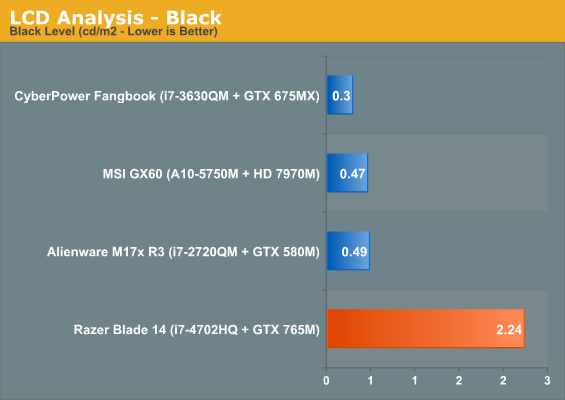
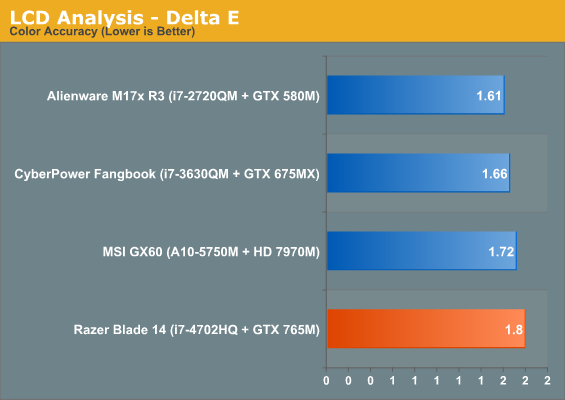
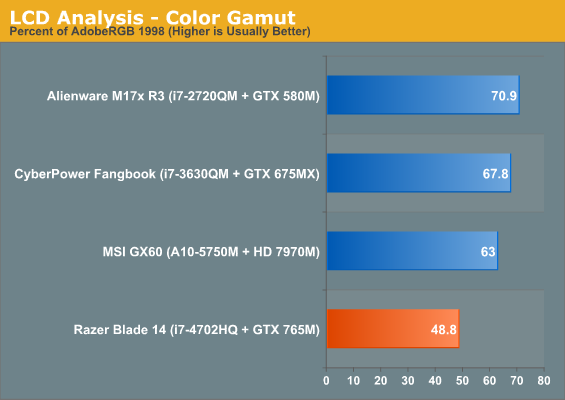
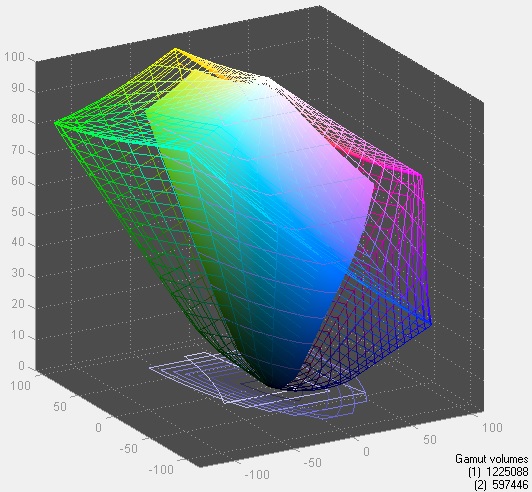
The Razer Blade 14-inch may be enjoying a 1600x900 resolution that's perfect for the gaming hardware included within, but the panel itself is atrocious. Razer was able to jack up the brightness to a respectable 453 nits, but it's a linear boost: the black level is a heinous 2.24 nits. There's just no excuse for this; Lenovo was able to get a 14", 1600x900 panel in their X1 Carbon that walks all over the Blade's. And Alienware is offering a 1080p IPS panel on their Alienware 14, a notebook that may be thicker but offers the same GPU, an optical drive, and a faster CPU. I was stunned by the Blade's beautiful design, and I was equally stunned by its dire screen quality, which suffers from the same nasty "no correct viewing angle" problem that cheap TN panels typically do.
Battery Life
It's hard to generate much enthusiasm for the Razer Blade 14-inch after discovering how poor the display quality on it is, but the flipside is that the battery life on it is pretty impressive. Razer was able to cram a 70Wh battery into the Blade, and leveraging the 37W quad-core and NVIDIA's Optimus allows them to eke out a healthy amount of mobility.

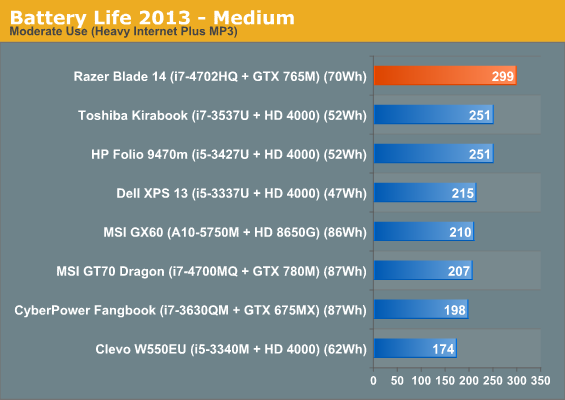
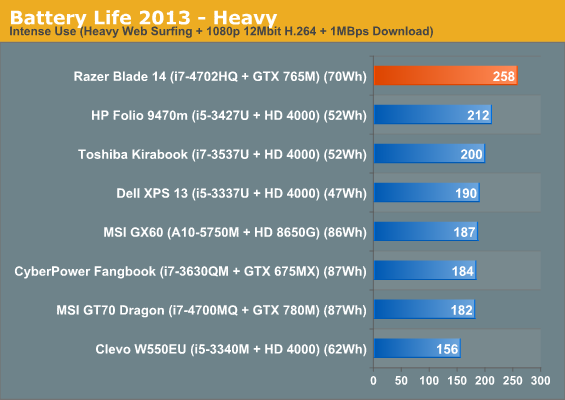
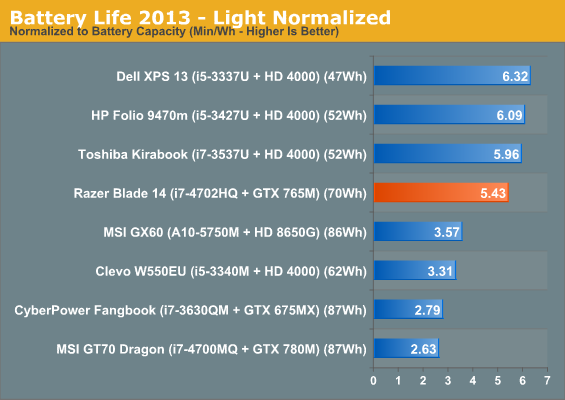

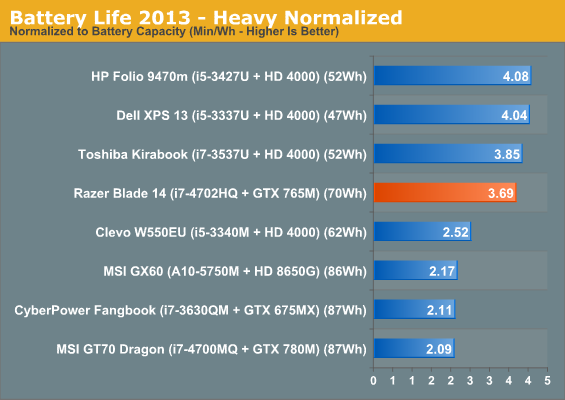
This is, without a doubt, a gaming ultrabook. Normalized power consumption is practically in line with full-on ultrabooks from the last generation sporting ULV processors, but Razer is able to do it with a full quad-core CPU and a beefy GPU (that turns off when not in use, naturally).
Heat and Noise
Razer was able to handle the balancing act of heat, noise, and chassis bulk with remarkable skill. I'm not sure they hit the absolute sweet spot, but they're awfully close to it. Fan noise is sub-40dB under load, which is actually pretty excellent for a gaming notebook. They're definitely playing "Thermal Chicken" with the surface temperatures, but unless you mash your giant hand down on the keyboard or keep poking the hinge with your fingertip (where most of the heat is), you're not going to be too uncomfortable.

The CPU temperatures definitely get up there and Razer is pretty close to playing with fire here, but in practice I found the system was ultimately able to handle thermals fairly well. If anything I feel like Razer has some room to improve here; I think they could spin up the fan on the CPU without having too negative an impact on system noise. Heat density is going to be much higher in the i7-4702HQ than it is in the GTX 765M; the 765M has 2.54 billion transistors on a 28nm process, and a good chunk of those transistors have been shut off. Meanwhile the i7-4702HQ 1.4 billion transistors on a 22nm process, and that's ignoring the marginal heat that's going to be produced by the on-package chipset.
I think there's still a little room for improvement here, and I'm never happy to see CPU core temperatures in the 90s, but it's not hitting throttling temperatures. Just remember that this notebook must take cool air in from the bottom. Other ultrabooks I'm a bit more critical of when they have bottom-intake cooling systems, but the Blade is handling 100W+ of silicon.










108 Comments
View All Comments
Dustin Sklavos - Tuesday, July 2, 2013 - link
If you think the rest of the industry is any different, I have a bridge to sell you. We review what we're sent, same as anyone else.But that doesn't make us a mouthpiece. I'd like to think we're pretty critical; we may review what we're sent, but we put the screws to it.
bji - Tuesday, July 2, 2013 - link
Why do you review only what you're sent? Can't you have a budget where you buy hardware, review it, and then re-sell it? Every review would cost a couple hundred bucks to produce but that can't be much averaged over the time you spent writing the review (if I spent 20 hours writing a review, the time cost would far exceed a couple of hundred dollars spent on the hardware), and also, you make advertising revenue ...p1esk - Tuesday, July 2, 2013 - link
Very good point. Besides, it would easy to resell when you have a huge audience of potential buyers.resination - Tuesday, July 2, 2013 - link
Heh. "This laptop is overpriced junk. Click here to buy ours."MySchizoBuddy - Tuesday, July 9, 2013 - link
point well made.kevith - Tuesday, July 2, 2013 - link
Seriously? Should Anand Lil Shimpi run around, shopping for hardware to review? And after reviewing it, they should spend time trying to resell it?I really don´t think that would work...
flyingpants1 - Tuesday, July 2, 2013 - link
Yes.Have a donation/kickstarter system to fund the hardware review budget. Once something is reviewed, slap a fancy Anandtech logo on it and sell it for a 20% loss.
Anything would be better than sitting and waiting for a manufacturer to send you a cherry-picked sample.
MySchizoBuddy - Tuesday, July 9, 2013 - link
the purpose of a reviewer is to test honestly what was handed to them. whether it is given to them or bought is irrelevant.JarredWalton - Tuesday, July 2, 2013 - link
A few hundred dollars isn't much less than what most hardware reviewers get paid to begin with. "Hey, can you go buy that $900 laptop, review it, resell it for $700, and we'll pay you the standard $400 for your review?" Reviewing hardware is nice, but when a full review can take 20-40 hours to put together (sometimes more), you can see that investing even four or five extra hours starts to really cut into the revenue/income.Then there's the fact that outside of Lenovo, we generally get most of the laptops that are really worth reviewing. We don't need to review every budget laptop, and we don't have the manpower to do so -- and the readership would get really tired of seeing multiple laptop reviews each week where 90% of the laptops are "average" -- okay for a certain price point, but with various flaws.
Should we need to essentially pay for the privilege of reviewing a specific manufacturer's hardware? Now add in the time it requires to resell a laptop, and the risk of fraud, and it's a big can of worms I'm not really keen to open. In fact, I know one site that tried to do this with desktop systems some years ago so that they could really see what the end user experience was like, including calling tech support to troubleshoot a problem. The reviews ended up not generating enough revenue to cover their cost, the section basically got axed, and the reviewer in question ended up working for one of the big tech companies.
JarredWalton - Tuesday, July 2, 2013 - link
I should also note that buying your own review units means your reviews will be, at best, several weeks after everyone else. That's not the end of the world, but it does mean about one third the traffic as being one of the first reviews.